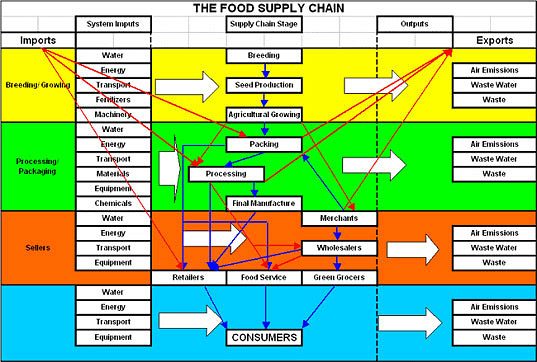JIT Food – Just In Time Food Delivery System Disaster Waiting To Happen
There really is no food inventory other than what’s on the grocery store shelves. There’s little or no warehousing backup in the event of a supply shortage, and everything gets to the shelves just in time…also known as JIT.
Our concentrated supermarket / grocery supply system uses JIT ( Just in Time ) technology efficiencies, enabled by computers and the Internet.
If there were a sudden unexpected high demand — the JIT delivery systems will break, or even fail – leaving grocery / supermarket shelves empty – for longer than you may think…
The food supply chain is more fragile than you may realize, due to over-active efficiencies.

We have been trained to expect its efficiency. The over-application of efficiency in grocery models and in the freight sector, means there’s little to no back-stock in goods. Instead, goods are ordered as quickly as they sell out, refilling shelves on a product by product basis. This means that in most grocers, what you see on the shelf, is all that they have.
Guest article by J.Presley – graduate from Harvard in Economics, and Stanford with an MBA.
(This article was originally published here during 2014. However I am re-posting due to relevance with the unfolding current events and ongoing supply channel disruptions.)
What Will Break The Just in Time System?
Massive Increase of Unsatisfiable Demand
My fears have centered upon a massive increase of unsatisfiable demand. This is a far more likely scenario than an immediate shutdown of food production at the source.
We know how quickly supermarket shelves go completely bare when people fear a blizzard or hurricane. This same thing could happen here in the US but it would be a permanent shortage. Here is how it would happen:
Almost All US Population Has Only A Few Days To A Week Of Food
First understand that almost all the US population buys food for a week or just a few days. They make trips to the market once or twice a week. They have little or no food reserves.
In econ-speak, their ‘preferences’ are to have reserve of one or two weeks.
But this preference is founded upon the public belief in the certainty and integrity of the food supply system. We have no worry that when we go to the market it will be chock full of everything we want.
A Sudden Demand
But imagine that something happened to change those preferences for reserves. Suppose the typical American wanted a two-month or six month reserve?
This could happen when they see food prices escalating beyond reach and they wish to buy reserve food while it is still within their price range.
[Ken adds: What if Americans en mass began to stock up food and supplies due to threat of deadly pandemic and the need for self-isolation or quarantine?]
Imagine what would happen:
JIT (Just in Time) Will Break
The demand for food would quintuple or more within a short time and so shoppers would see empty shelves in the market, further stimulating panic buying, just as in a hurricane or blizzard. This would mark the end of our reliable food supply system.
The stores would be picked clean almost instantly and people’s preferences would change even more toward having a year of reserve food or more to protect themselves from outages.
Given that we have no warehousing and a near-fixed resupply capability, we would be looking at a PERMANENT condition of no food on the shelves. Armed men would meet the resupply trucks when they arrive at the market.
Martial law, price controls, and food rationing with the then current President as Commander, would follow, as well as a suspension of our many rights (to bear arms, prohibitions against search and seizure, property rights). This would be with the blessing of the many hungry people.
We have a precarious situation indeed. And the only way to protect oneself and family is to PREPARE.
[ Read: When The Trucks STOP, IT’S OVER… ]

